Lesson 7.2: Mendelian Inheritance
Lesson 7.2: Mendelian Inheritance
Lesson Objectives
Identify how probability is used to predict outcomes of genetic crosses.
Outline how a Punnett Square helps predict outcomes of genetic crosses.
Identify how probability can help determine the alleles in a gamete.
Identify how a testcross is used to determine the genotype of an organism.
Describe how monohybrid and dihybrid crosses differ.
Identify the ratio of phenotypes that appeared in Mendel’s dihybrid crosses.
Examine how a pedigree is used in the study of human inheritance.
Describe how codominance does not follow Mendelian Inheritance.
Describe how incomplete dominance does not follow Mendelian Inheritance.
Identify examples of polygenic traits in humans.
Outline how heredity and environment can interact to affect phenotype.
Introduction
A Mendelian trait is a trait that is controlled by a single gene that has two alleles. One of these alleles is dominant and the other is recessive. Several inheritable conditions in humans are passed to offspring in a simple Mendelian fashion. Medical professionals use Mendel’s laws to predict and understand the inheritance of certain traits in their patients. Also, farmers, animal breeders, and horticulturists who breed organisms can predict outcomes of crosses by understanding Mendelian inheritance.
Calculating Probability
The rules of probability that apply to tossing a coin or throwing a dice also apply to the laws of segregation and independent assortment. Probability is the likelihood that a certain event will occur. It is expressed by comparing the number of events that occur to the total number of possible events. The equation is written as:
Probability = (number of times an event is expected to occur/total number of times an event could happen)
For example, in Mendel’s F2 hybrid generation, the dominant trait of purple flower color ap- peared 705 times, and the recessive trait appeared 224 times. The dominant allele appeared 705 times out of a possible 929 times (705+224=929).
Probability = (705/929) (705/929)= 0.76
The probability the recessive trait will appear in the F2 hybrid generation is calculated in the same way.
Probability = (224/929) (224/929) = 0.24
The probability of the recessive trait appearing in the F2 generation is 24% or about ¼.
Results predicted by probability are most accurate when many trials are done. The best way to illustrate this idea is to toss a coin. Because a coin has two sides, every time you toss it the chance of tossing heads or tossing tails is 50%. The outcome of each separate toss is unaffected by any previous or future result. For example, imagine you tossed seven heads in a row. You would think that the next toss is more likely to be a tail, but the possibility of tossing another head is still 50%. If you tossed the coin a total of ten times, a total of seven heads and three tails, you would calculate the probability of tossing heads is 70%. The fact that you carried out only a small number of trials has affected your results. If Mendel had grown only 10 plants, he would have gotten different probabilities for the appearance of dominant and recessive traits. However, Mendel carried out many thousands of trials. He was therefore sure that his results were due to probability, and not to chance.
Probability and the Law of Segregation
Each coin toss is a separate event. Likewise, gamete formation is a separate event. The probability that a Pp heterozygote produces gametes with a P allele or a p allele is 50% for each gamete cell. In a fertilization involving two such plants (as in the F1 generation self-pollination experiment), each pollen cell and each egg cell have a 50% chance of having the P or p allele.
Predicting Genotypes with Punnett Squares
Mendel developed the law of segregation by following only a single characteristic, such as pod color, in his pea plants. Biologists use a diagram called a Punnett Square, to help predict the probable inheritance of alleles in different crosses.
In a monohybrid cross, such as the one in Figure 7.7, the Punnett square shows every possible combination when combining one maternal (mother) allele with one paternal (father) allele. In this example, both organisms are heterozygous for flower color Pp (purple). Both plants produce gametes that contain both the P and p alleles. The probability of any single offspring showing the dominant trait is 3:1, or 75%.

Using Probability to Determine Alleles in Gametes
In the monohybrid cross shown in Figure 7.7, two heterozygous plants are crossed. Both plants produce gametes, all of which contain either a P or p allele for flower color. The likelihood that any particular gamete contains the allele for a white flower can be calculated. Because a gamete can only carry one out of two alleles, there are only two possible outcomes
for a gamete. The probability that a gamete will carry the allele for white flower color is ½, 0.5, or 50%. The probability that a gamete will carry the allele for purple flower color is also
½.
Using Probability in a Heterozygous Cross
We can calculate the probability of any one of the offspring being heterozygous (Pp) or homozygous (PP or pp) for flower color. The probability of a plant inheriting the P or p allele from a heterozygous parent is ½. Multiply the probabilities of inheriting both alleles to find the probability that any one plant will be a pp homozygote.
½ × ½ = ¼ or 0.25
Only 25 %, or one outcome out of four, will result in a plant homozygous for white flower color (pp). The possibility that any one plant will be a PP homozygote is also 1/4. The heterozygous allele combination can happen twice (Pp or pP), so the two probabilities are added together ¼ + ¼ = 2/4, or ½. The probability that an offspring plant will be Pp heterozygous is ½.
Testcross and Punnett Squares
Suppose you have a purple and white flower and, as discussed above, purple color is dominant to white. The white flower must be homozygous for the recessive allele, but the genotype of the purple flower is unknown. It could be either PP or Pp. A testcross will determine the organism’s genotype. In a testcross, the individual with the unknown genotype is crossed with a homozygous recessive individual (Figure 7.8). The unknown genotype can be determined by observing the phenotypes of the resulting offspring.
Dihybrid Crosses and Punnett Squares
Dihybrid crosses are more complicated than monohybrid crosses because more combinations of alleles are possible. For example, tracking the inheritance of seed color and pod color in a Punnett square requires that we track four alleles. G is the dominant allele for green pod color and g is the recessive allele for yellow pods. Y is the dominant allele for yellow seed color and y is the recessive allele for green seed color.
Two plants are crossed, one is true-breeding for green pods and yellow seeds (GGYY), the other is true-breeding for yellow pods and green seeds (ggyy). All of the F1 generation will be heterozygous for both traits (GgYy). Figure 7.9, shows the dihybrid cross of the dihybrid P generation and the F1 generation.
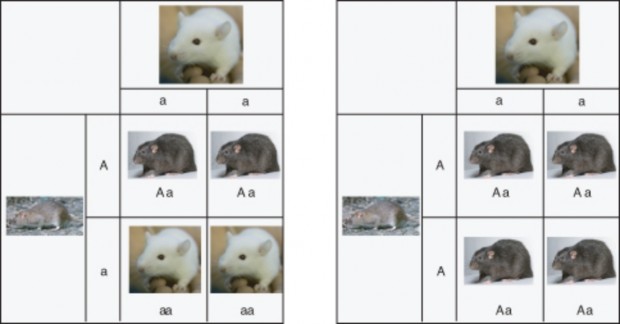
Figure 7.8: A testcross helps reveal the genotype of an organism when that organism shows the dominant trait, such as agouti coat color in rats. Such an organism could be homozygous dominant or heterozygous. Agouti is the common color of the Norway rat, Rattus norvegicus. (12)
In a dihybrid cross, four alleles can be inherited from any one parent at one time. When two heterozygous individuals are crossed, there are a total of 16 possible combinations of the four alleles. The phenotypes of the offspring with two independent traits show a 9:3:3:1 ratio. In a cross involving pea plants heterozygous for round, yellow seeds (GgYy), 9/16 plants have round, yellow seeds, 3/16 have round, green seeds, 3/16 have wrinkled, yellow seeds, and 1/16 has wrinkled, green seeds.
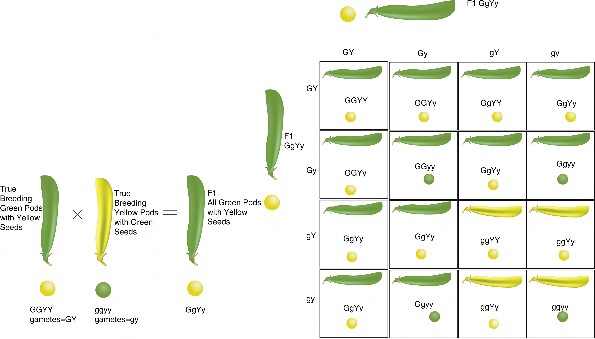
Mendelian Inheritance in Humans
A pedigree is a chart which shows the inheritance of a trait over several generations. A pedigree is commonly created for families, and it outlines the inheritance patterns of genetic disorders. Figure 7.10 shows a pedigree depicting recessive inheritance of a disorder through three generations. Scientists can tell the genetics of inheritance from studying a pedigree, such as whether the trait is sex-linked (on the X or Y chromosome) or autosomal (on a chromosome that does not determine sex), whether the trait is inherited in a dominant
or recessive fashion, and possibly whether individuals with the trait are heterozygous or homozygous.

Is the trait sex-linked or autosomal? A sex chromosome is a chromosome that determines the sex of an organism. Humans have two sex chromosomes, X and Y. Females have two X chromosomes (XX), and males have one X and one Y (XY). An autosome is any chromosome other than a sex chromosome. If a trait is autosomal it will affect males and females equally.
A sex-linked trait is a trait whose allele is found on a sex chromosome. The human X chromosome is significantly larger than the Y chromosome; there are many more genes located on the X chromosome than there are on the Y chromosome. As a result there are many more X-linked traits than there are Y-linked traits. Most sex-linked traits are recessive. Because males carry only one X chromosome, if they inherit a recessive sex-linked gene they will show a sex-linked condition.
Because of the recessive nature of most sex-linked traits, a female who shows a sex-linked condition would have to have two copies of the sex-linked allele, one on each of her X
chromosomes. Figure 7.11 shows how red-green colorblindness, a sex-linked disorder, is passed from parent to offspring.

Is the Trait Dominant or Recessive? If the trait is autosomal dominant, every person with the trait will have a parent with the trait. If the trait is recessive, a person with the trait may have one, both or neither parent with the trait. An example of an autosomal dominant disorder in humans is Huntington’s disease (HD). Huntington’s disease is a degenerative disease of the nervous system. It has no obvious effect on phenotype until the person is aged 35 to 45 years old. The disease is non-curable and, eventually, fatal. Every child born to a person who develops HD has a 50% chance of inheriting the defective allele from the parent.
Are the Individuals with the Trait Heterozygous or Homozygous? If a person is homozygous or heterozygous for the dominant allele of a trait, they will have that trait. If the person is heterozygous for a recessive allele of the trait, they will not show the trait. A person who is heterozygous for a recessive allele of a trait is called a carrier. Only people who are homozygous for a recessive allele of a trait will have the trait.
Non-Mendelian Modes of Inheritance
The relationship between genotype and phenotype is rarely as simple as the examples Mendel studied. Each characteristic he studied had two alleles, one of which was completely domi- nant and the other completely recessive. Geneticists now know that alleles can be codomi- nant, or incompletely dominant.
Codominance occurs when both traits appear in a heterozygous offspring. Neither allele is completely dominant nor completely recessive. For example, roan shorthorn cattle have codominant genes for hair color. The coat has both red and white hairs. The letter R indicates red hair color, and R’ white hair color. In cases of codominance, the genotype of the organism can be determined from its phenotype. The heifer in Figure 7.12 is RR’ heterozygous for coat color.
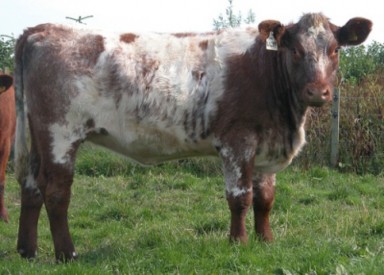
Incomplete Dominance
Incomplete dominance occurs when the phenotype of the offspring is somewhere in between the phenotypes of both parents; a completely dominant allele does not occur. For example, when red snapdragons (CRCR)</math> are crossed with white snapdrag- ons (CWCW), the F1 hybrids are all pink hetrozygotes for flower color (CRCW). The pink color is an intermediate between the two parent colors. When two F1 (CRCW) hybrids are crossed they will produce red, pink, and white flowers. The genotype of an organism with incomplete dominance can be determined from its phenotype (Figure 7.13).
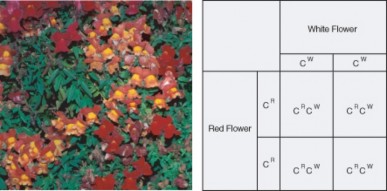
Complex Forms of Heredity
Traits that are affected by more than one gene are called polygenic traits. The genes that affect a polygenic trait may be closely linked on a chromosome, unlinked on a chromosome, or on different chromosomes. Polygenic traits are often difficult for geneticists to track because the polygenic trait may have many alleles. Also, independent assortment ensures the genes combine differently in gametes. Therefore, many different intermediate phenotypes exist in offspring. Eye color (Figure 7.14), and skin color are examples of polygenic traits in humans.

When three or more alleles determine a trait, the trait is said to have multiple alleles. The human ABO blood group is controlled by a single gene with three alleles: i, IA, IB, and the recessive i allele. The gene encodes an enzyme that affects carbohydrates that are found on the surface of the red blood cell. A and B refer to two carbohydrates found on the surface of red blood cells. There is not an O carbohydrate. Type O red blood cells do not have either
type A or B carbohydrates on their surface.
The alleles IA and IB are dominant over i. A person who is homozygous recessive ii has type O blood. Homozygous dominant IAIA or heterozygous dominant IAi have type A blood, and homozygous dominant IBIB or heterozygous dominant IBi have type B blood. IAIB people have type AB blood, because the A and B alleles are codominant. Type A and type B parents can have a type AB child. Type A and a type B parent can also have a child with Type O blood, if they are both heterozygous (IBi,IAi). The table (7.3) shows how the different combinations of the blood group alleles can produce the four blood groups, A, AB, B, and O.
Table 7.3: Bloodtype as Determined by Multiple Alleles
IA IB i
IA IAIA
TYPE A
IB IA IB
TYPE AB
i i IA
TYPE A
IAIB TYPE AB
IB IB TYPE B
i IB TYPE B
IAi TYPE A
IB i TYPE B
ii
TYPE O
Effects of Environment on Phenotype
Genes play an important part in influencing phenotype, but genes are not the only influ- ence. Environmental conditions, such as temperature and availability of nutrients can affect phenotypes. For example, temperature affects coat color in Siamese cats.
The pointed pattern is a form of partial albinism, which results from a mutation in an enzyme that is involved in melanin production. The mutated enzyme is heat-sensitive; it fails to work at normal body temperatures. However, it is active in cooler areas of the skin. This results in dark coloration in the coolest parts of the cat’s body, such as the lower limbs and the face, as shown in Figure 7.15. The cat’s face is cooled by the passage of air through the nose. Generally adult Siamese cats living in warm climates have lighter coats than those in cooler climates.
Height in humans is influenced by many genes, but is also influenced by nutrition. A person who eats a diet poor in nutrients will not grow as tall as they would have had they eaten a more nutritious diet. Scientists often study the effects of environment on phenotype by studying identical twins. Identical twins have the same genes, so phenotypic differences between twins often have an environmental cause.
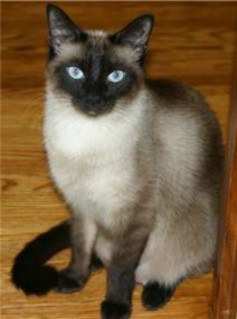
Probability is the likelihood that a certain event will occur. It is expressed by compar- ing the number of events that actually occur to the total number of possible events. Probability can be expressed as a fraction, decimal, or ratio.
A Punnett square shows all the possible genotypes that can result from a given cross.
A testcross examines the genotype of an organism that shows the dominant phenotype for a given trait. The heterozygous organism is crossed with an organism that is homozygous recessive for the same trait.
A dihybrid cross-examines the inheritance of two traits at the same time.
A pedigree can help geneticists discover if a trait is sex-linked, if it is dominant or reces- sive, and if the person (or people) who have the trait are homozygous or heterozygous for that trait.
The Mendelian pattern of inheritance and expression does not apply to all traits. Codominant traits, incompletely dominant traits, and polygenic traits do not follow simple Mendelian patterns of inheritance. Their inheritance patterns are more complex.
An organism’s phenotype can be influenced by environmental conditions.
Review Questions
Further Reading / Supplemental Links
What does the probability equation help to determine?
How can probability be expressed?
Outline how Punnett squares are useful.
Identify the purpose of a testcross.
How do the Punnett squares for a monohybrid cross and a dihybrid cross differ?
Mendel carried out a dihybrid cross to examine the inheritance of the characteristics for seed color and seed shape. The dominant allele for yellow seed color is Y, and the recessive allele for green color is y. The dominant allele for round seeds is R, and the recessive allele for a wrinkled shape is r. The two plants that were crossed were F1 dihybrids RrYy. Identify the ratios of traits that Mendel observed in the F2 generation, and explain in terms of genotype what each number means. Create a Punnett square to help you answer the question.
Draw a pedigree that illustrates the passing of the dominant cleft chin trait through three generations. A person who has two recessive alleles does not have a cleft chin. Let us say that C is the dominant allele, c is the recessive allele.
A classmate tells you that a person can have type AO blood. Do you agree? Explain.
Mendelian inheritance does not apply to the inheritance of alleles that result in incom- plete dominance and codominance. Explain why this is so.
Outline the relationship between environment and phenotype.
http://www.nbii.gov/portal/server.pt?open=512&amp;objID=405&amp;PageID=581&amp;mode=2&amp;in_hi_userid=2&amp;cached=true
http://omia.angis.org.au/retrieve.shtml?pid=417
http://www.curiosityrats.com/genetics.html
http://www.macalester.edu/psychology/whathap/UBNRP/visionwebsite04/twotypes. html
http://www.newton.dep.anl.gov/askasci/mole00/mole00087.htm
http://www.hhmi.org/biointeractive/vlabs/cardiology/content/dtg/pedigree/ pedigree.html
http://www.ndsu.nodak.edu/instruct/mcclean/plsc431/mendel/mendel9.htm
http://www.emc.maricopa.edu/faculty/farabee/BIOBK/BioBookgeninteract.html
Vocabulary
autosome Any chromosome other than a sex chromosome.
carrier A person who is heterozygous for a recessive allele of a trait.
codominance Occurs when both traits appear in a heterozygous individual.
incomplete dominance Occurs when the phenotype of the offspring is somewhere in be- tween the phenotypes of both parents; a completely dominant allele does not occur.
Mendelian trait A trait that is controlled by a single gene that has two alleles.
multiple alleles When three or more alleles determine a trait, such as with the human ABO blood group.
probability The likelihood that a certain event will occur.
pedigree A chart which shows the inheritance of a trait over several generations.
polygenic traits Traits that are affected by more than one gene.
Punnett square A diagram that helps predict the probable inheritance of alleles in dif- ferent crosses.
sex chromosome A chromosome that determines the sex of an organism. sex-linked trait A trait whose allele is found on a sex chromosome. testcross A cross used to determine an unknown genotype.
Points to Consider
The next chapter is Molecular Genetics.
What do you think Molecular Genetics refers to?
How can DNA contain all the genetic information?
If DNA is in the nucleus, and proteins are made on ribosomes in the cytoplasm, how do you think this happens?
Image Sources
CK-12 Foundation. http://commons.wikimedia.org/wiki/Image: Blauwschokker_Kapucijner_rijserwt_bloem_Pisum_sativum.jpg. GNU-FDL.
Bmdavll. http://en.wikipedia.org/wiki/Image:Snow_pea_flowers.jpg. GNU-FDL.
http://commons.wikimedia.org/wiki/Image:Mendel.png. Public Domain.
Rozzychan. http://en.wikipedia.org/wiki/Image:PedigreechartB.png. CC-BY-SA 2.5.
CK-12 Foundation,Forest & Kim Starr.
http://commons.wikimedia.org/wiki/File:
Starr_980630-1518_Antirrhinum_majus.jpg. CC-BY 3.0.
CK-12 Foundation. http://commons.wikimedia.org/wiki/Image: Blauwschokker_Kapucijner_rijserwt_bloem_Pisum_sativum.jpg. GNU-FDL.
Robert Scarth. http://www.flickr.com/photos/robert_scarth/63966084/. CC-BY-SA 2.0.
http://commons.wikimedia.org/wiki/Image:Illustration_Pisum_sativum0.jpg. Public Domain.
http://commons.wikimedia.org/wiki/File:Niobe050905-Siamese_Cat.jpeg. GNU-FDL.
Bertas la Blanquita. http://commons.wikimedia.org/wiki/File:Albino_girl_honduras.jpg. CC-BY-SA.
CK-12 Foundation. http://www.flickr.com/photos/forbiddendoughnut/462468304/in/datetaken/http://www.flickr.com/photos/alexk100/444028894/in/datetaken/.
CC-BY-SA 2.0.
Niamh Gray Wilson. . CC-BY-SA.
http://www.flickr.com/photos/marypaulose/292958125/ http://www.flickr.com/photos/publicdomainphotos/3478083781/. CC-BY-SA, CC-BY.
- Log in or register to post comments
- Email this page
